The Tanargue Massif in Ardèche |

 The Tanargue, a majestic giant of the Central Massif, stands like a stone guardian, reaching 1,511 meters at the summit of Grand Tanargue. Stretching between west and east over a distance of 15 to 20 kilometers, its wingspan encompasses about 50 kilometers, covering an area of 4,726 hectares. Nicknamed the "Mountain of Thunder," it resonates with whispers of past storms.
The Tanargue, a majestic giant of the Central Massif, stands like a stone guardian, reaching 1,511 meters at the summit of Grand Tanargue. Stretching between west and east over a distance of 15 to 20 kilometers, its wingspan encompasses about 50 kilometers, covering an area of 4,726 hectares. Nicknamed the "Mountain of Thunder," it resonates with whispers of past storms.
Its Cévenol climate, characterized by some of the heaviest rainfall in mainland France, weaves a veil of mist and greenery over its slopes. The Tanargue is a living canvas, a muse for storytellers and artists, that has nurtured numerous legends and works in the heart of Ardèche.
The paths of the Tanargue are trodden by the footsteps of modern adventurers, cyclists, and hikers, who come seeking the echo of wild nature. In winter, its slopes adorn themselves in white and come alive with the seasons, thanks to a ski resort that beats to the capricious rhythm of the climate. Classified as a type I ZNIEFF and nestled in the regional natural park of the Monts d'Ardèche, the Tanargue is a sanctuary for biodiversity, an environmental treasure to be preserved.
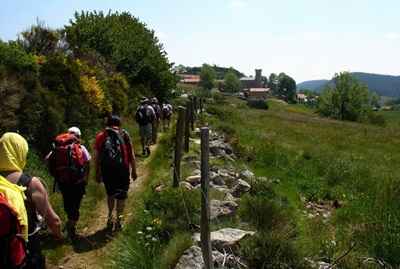 At the heart of this landscape, the agropastoral tradition still beats, symbolized by the last transhumance of Ardèche, where sheep roam the moors like in an eternal pastoral painting. The chestnut groves, remnants of a bygone era, continue to thrive, maintained by the hands of those who perpetuate the heritage of the land. The Tanargue, Mountain of Thunder, remains a living symbol of the resilience and richness of Ardèche.
At the heart of this landscape, the agropastoral tradition still beats, symbolized by the last transhumance of Ardèche, where sheep roam the moors like in an eternal pastoral painting. The chestnut groves, remnants of a bygone era, continue to thrive, maintained by the hands of those who perpetuate the heritage of the land. The Tanargue, Mountain of Thunder, remains a living symbol of the resilience and richness of Ardèche.
The Tanargue, this jewel of southwestern Ardèche, stands at the borders of Lozère, embraced by the preserved nature of the regional natural park of the Monts d'Ardèche. It is surrounded by the mountains of Vivarais and the Devès massif to the north, the Rhône Valley to the east, Mont Lozère to the south, and the Margeride mountains to the west. While it shares the spirit of the Cévennes, the Tanargue distinguishes itself, standing outside the boundaries of the Cévennes area, which ends at Mont Lozère, 35 kilometers further south.
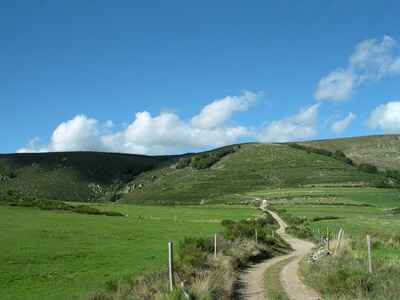 Eleven municipalities, like pearls, are scattered around this massif: Borne, Jaujac, Joannas, Laboule, Loubaresse, Prunet, Rocles, Saint-Étienne-de-Lugdarès, Saint-Laurent-les-Bains, La Souche, and Valgorge. They once formed the S.I.A.T, an intercommunal union dedicated to the tourist and agricultural development of the region, dissolved on February 22 by administrative decision. This union also brought together other localities that guard the borders of the Tanargue: Astet, Cellier-du-Luc, Laval-d’Aurelle, Lanarce, Laveyrune, Le Plagnal, Montselgues, and Saint-Alban-en-Montagne, all witnesses to the history and culture of this unique territory.
Eleven municipalities, like pearls, are scattered around this massif: Borne, Jaujac, Joannas, Laboule, Loubaresse, Prunet, Rocles, Saint-Étienne-de-Lugdarès, Saint-Laurent-les-Bains, La Souche, and Valgorge. They once formed the S.I.A.T, an intercommunal union dedicated to the tourist and agricultural development of the region, dissolved on February 22 by administrative decision. This union also brought together other localities that guard the borders of the Tanargue: Astet, Cellier-du-Luc, Laval-d’Aurelle, Lanarce, Laveyrune, Le Plagnal, Montselgues, and Saint-Alban-en-Montagne, all witnesses to the history and culture of this unique territory.
In the deep valleys and steep gorges of Ardèche, the land keeps echoes of a distant past. The caves of Soyons, silent witnesses, whisper stories from 150,000 years ago, when prehistoric man trod upon these mysterious lands. The Chauvet cave, hidden near the tumultuous gorges, reveals frescoes that tell of a time when man and nature were inseparable.
When Julius Caesar expanded his empire, the Tanargue, this proud massif, stood in the territory of the Helvii, a Gallic people as robust as the mountains they inhabited. After the tumult of war, the Helvii and their land were enveloped in the mantle of the Roman province of Narbonnaise, a new chapter in their millennia-old history.
The Middle Ages saw the Tanargue awaken in a new light. A local notable, in an act of faith and power, offered these lands to the diocese of Viviers. And thus, in the ninth century, the Tanargue was woven into the ecclesiastical tapestry of the region. In 1271, Vivarais, like Gévaudan and Velay, was absorbed into Languedoc, uniting various lands under one banner.
 The Renaissance brought with it the changing winds of the Religious Wars. As the Cévennes and Vivarais tore themselves apart in conflict, the Tanargue remained a bastion of the Catholic faith. This loyalty made its lands a battlefield for the Huguenot troops, and Vivarais was marked by the scars of these struggles. The siege of Privas, the merciless dragonnades, and even the massacres of civilians left indelible marks on the heart and soul of the province.
The Renaissance brought with it the changing winds of the Religious Wars. As the Cévennes and Vivarais tore themselves apart in conflict, the Tanargue remained a bastion of the Catholic faith. This loyalty made its lands a battlefield for the Huguenot troops, and Vivarais was marked by the scars of these struggles. The siege of Privas, the merciless dragonnades, and even the massacres of civilians left indelible marks on the heart and soul of the province.
But it was in the early 18th century that the Tanargue was shaken by the repercussions of the Camisard War, a final surge of violence that set the Cévennes ablaze. And in the 1750s, the beast of Gévaudan spread terror, with young Jeanne Boulet, who fell to the west of the massif, as the first victim of its wild fury. These lands, steeped in history and legends, continue to captivate those who listen to the whispers of the past.
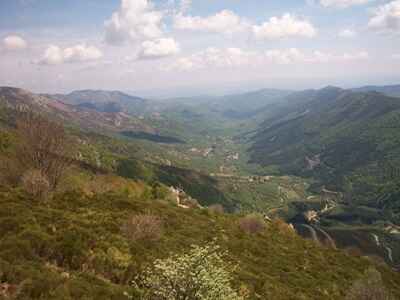 At the twilight of the 18th century, the Tanargue, this sleeping giant, awakened to join the newly formed department of the Sources of the Loire, which would soon take on the name of Ardèche. March 4, 1790 marked the dawn of a new era, and the Tanargue, like a patriarch, gave its name to the newly formed district. Joyeuse, then Jaujac, were the lanterns guiding this district, lighting the path of history.
At the twilight of the 18th century, the Tanargue, this sleeping giant, awakened to join the newly formed department of the Sources of the Loire, which would soon take on the name of Ardèche. March 4, 1790 marked the dawn of a new era, and the Tanargue, like a patriarch, gave its name to the newly formed district. Joyeuse, then Jaujac, were the lanterns guiding this district, lighting the path of history.
The neighboring villages of the Tanargue, nestled in the folds of its mountains, witnessed the fury of the elements, suffering the repeated assaults of overflowing rivers. The cévenol episodes, like unleashed dragons, ravaged the land in 1840 and 1856. But it was in September 1890 that the sky shed its tears with unparalleled rage, pouring nearly 950 mm of water in five days, sculpting the landscape with millennial force.
At the dawn of the 20th century, the Tanargue saw its children depart, swept away by the winds of rural exodus. The once robust chestnut trees wept their black ink, while the mulberry trees shivered under the blow of the pebble disease. The fields emptied, and hearts turned toward the distant lights of Lyon, Saint-Étienne, and Marseille, in search of a future forged in industry. The Great War claimed lives, leaving behind ghost villages where silence resonated louder than the cannons.
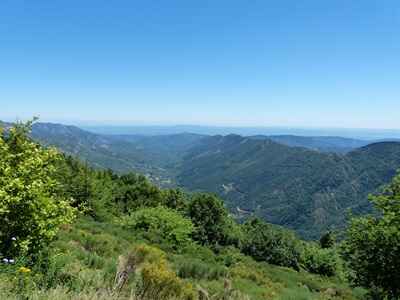 But like the phoenix rising from its ashes, the Tanargue saw a renewal at the threshold of the 1990s. Green tourism blossomed on its slopes, and new rural dwellers, attracted by the promise of a haven of peace, came to sow the seeds of a prosperous future. Aubenas, in its suburban expansion, reached out to the municipalities of the east, weaving a network of life that embraced the massif in a wave of rebirth.
But like the phoenix rising from its ashes, the Tanargue saw a renewal at the threshold of the 1990s. Green tourism blossomed on its slopes, and new rural dwellers, attracted by the promise of a haven of peace, came to sow the seeds of a prosperous future. Aubenas, in its suburban expansion, reached out to the municipalities of the east, weaving a network of life that embraced the massif in a wave of rebirth.
On the plateau of Tanargue, a pastoral ballet unfolds every summer, from June to September, where 1,300 meat sheep (BMC, Red of Roussillon, and others) dance to the rhythm of transhumance, guided by two devoted shepherds. It is the last of these ancestral traditions in Ardèche, a living echo of a bygone time.
The sunny slopes of the Tanargue are adorned with chestnut groves, green sentinels guarding up to 1,000 meters in altitude. Abandoned, they are only accessible by mule paths or on foot, testifying to the harshness of life in the past. But near the hamlets of Valousset, Valos, and Laboule, these trees thrive, nurtured by those who still draw their livelihood from these fruits of the earth. In the shadow of the massif, where the cold reigns, the chestnut trees give way to wild nature.
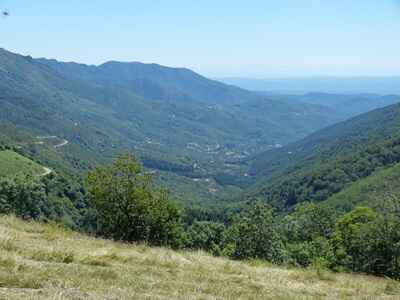 Once, the peasants of these hamlets, in a herculean effort, harvested the grass from the high plateaus and carried 80 kg loads of hay on their shoulders. Three hours of walking, a Sisyphus journey repeated day after day, to feed more than 7,000 sheep that populated the summer pastures at that time. These tales of labor and perseverance weave the rich tapestry of the history of Tanargue.
Once, the peasants of these hamlets, in a herculean effort, harvested the grass from the high plateaus and carried 80 kg loads of hay on their shoulders. Three hours of walking, a Sisyphus journey repeated day after day, to feed more than 7,000 sheep that populated the summer pastures at that time. These tales of labor and perseverance weave the rich tapestry of the history of Tanargue.
In the mystical west, where the ancient beech and fir forests whisper centuries-old stories, stands the Chambons state forest. A sanctuary of greenery where the high-altitude meadows kiss the sky, and the subalpine moors stretch like a carpet under the majestic rock bars. Here, the screes are castles for the streams that sing in the abundance of moisture.
At the heart of this picture, the artificial plantations, witnesses from the 1980s, stand timidly, dominated by conifers. These green sentinels, born from the hand of man after the tumult of war, remind us of the time when the National Forest Office saw in conifers the future of forestry. But the winds of change blow over the Tanargue, where a movement of rebirth erases the traces of these plantations to restore the land to its pastoral face. Twenty hectares of pines disappear, making way for the heath, revitalized by the generosity of the regional natural park. And in the state forest, a delicate dance of sunny clearings preserves the marshes and the subalpine jewels, like the marsh blueberries, guardians of the fragile balance of this biotope.
The fauna is a symphony of wild life. Birds of prey, such as the noble Circaète Jean-le-Blanc and the graceful Montagu's harrier, reign in the skies, while the discreet otter carves its path in the Borne river since the dawn of 1998. The Lignon, in turn, is the prosperous home of European beavers, tireless architects. And in the shadows of the woods, wild boars and deer orchestrate a rebirth, testifying to the regained vitality of these ancestral lands.
Former holiday hotel with a garden along the Allier, L'Etoile Guest House is located in La Bastide-Puylaurent between Lozere, Ardeche, and the Cevennes in the mountains of Southern France. At the crossroads of GR®7, GR®70 Stevenson Path, GR®72, GR®700 Regordane Way, GR®470 Allier River springs and gorges, GRP® Cevenol, Ardechoise Mountains, Margeride. Numerous loop trails for hiking and one-day biking excursions. Ideal for a relaxing and hiking getaway.
Copyright©etoile.fr